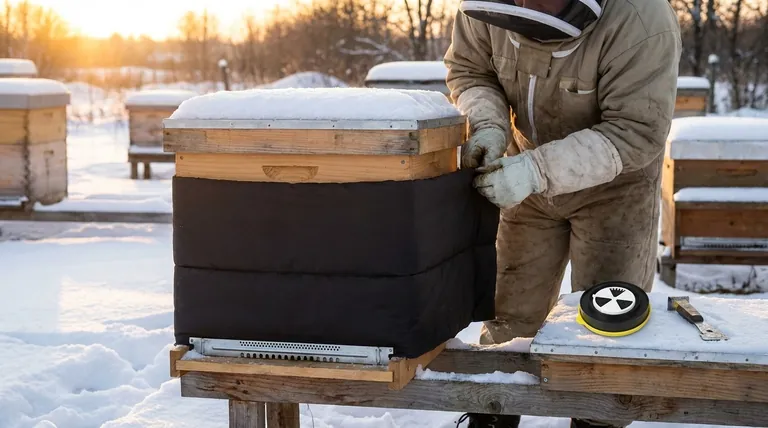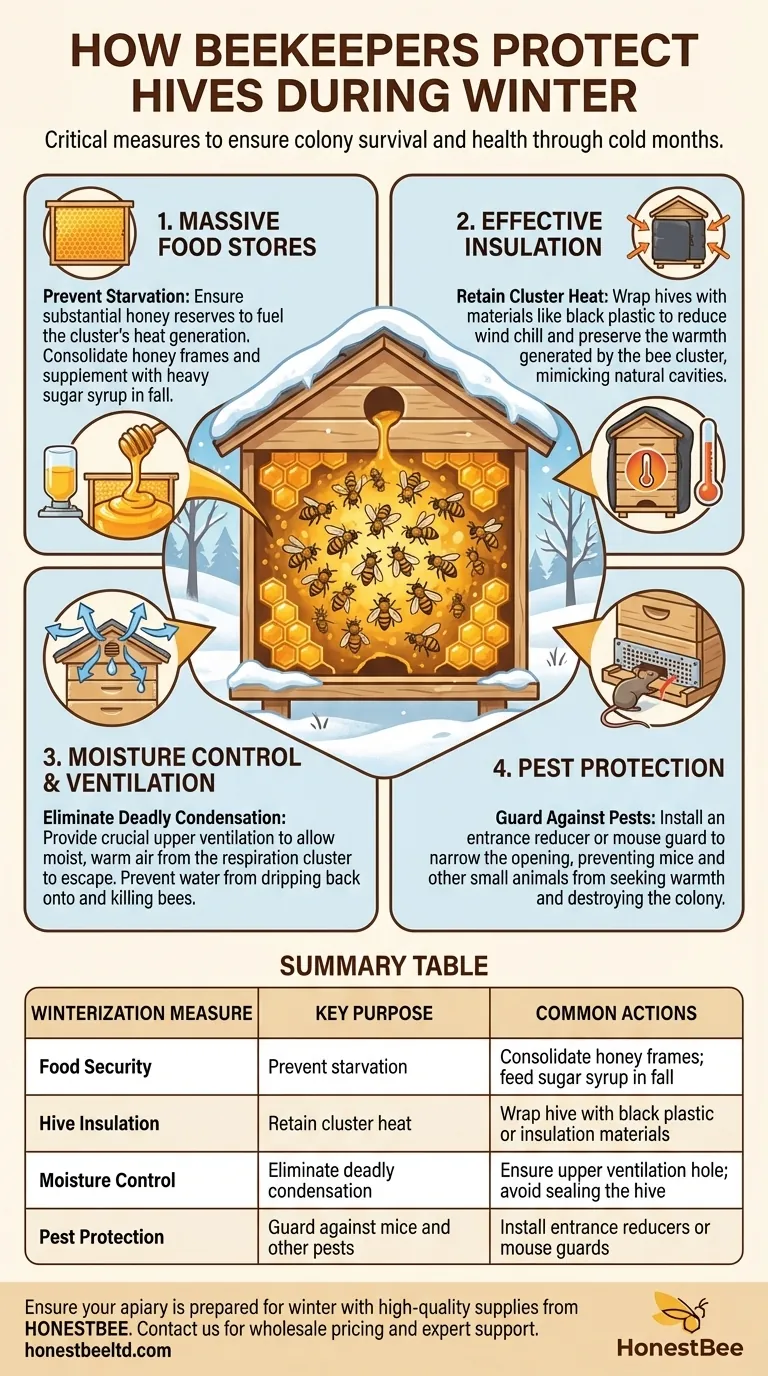To protect hives during winter, beekeepers focus on four critical areas: ensuring the colony has massive food stores, insulating the hive against heat loss, providing adequate ventilation to control deadly moisture, and securing the hive against pests like mice. This preparation begins in the late summer and fall to ensure the colony is strong, healthy, and well-provisioned before the first freeze.
The primary goal of winterizing a beehive is not just to keep it warm, but to create a stable internal environment. The biggest threats to a colony are often not the cold itself, but starvation and moisture condensation, which the beekeeper must proactively manage.

The Foundation: A Strong and Healthy Colony
Before any winter-specific preparations, the hive's survival depends on its health and population size going into the cold season.
The Importance of Pre-Winter Health
A colony weakened by pests or disease has little chance of surviving winter. Beekeepers conduct varroa mite testing and treatments throughout the summer and fall, as a high mite load is a leading cause of colony collapse.
Only strong, disease-free colonies should be prepared for winter. A large population is essential, as the bees generate heat by forming a tight cluster and vibrating their wing muscles.
Managing the Hive's Enemies: Starvation and Cold
Winter is a period of resource scarcity. The beekeeper's job is to ensure the bees have the two things they need most: fuel (food) and a defensible shelter.
Securing Adequate Food Stores
Starvation is a primary cause of winter colony death. A hive needs a substantial amount of honey to fuel the winter cluster, which generates constant heat.
Beekeepers often consolidate honey frames into a single hive body. This ensures the cluster does not have to break apart and cross a cold, empty space to reach another food source, which can cause them to freeze.
If natural honey stores are insufficient after the final harvest, beekeepers supplement with heavy sugar syrup in the fall.
Insulating the Hive Body
While hives are designed to mimic natural cavities like tree trunks, their thin walls offer limited insulation. Beekeepers often wrap hives to mitigate this.
Using black plastic wrap or other insulation materials helps reduce wind exposure and retain the heat generated by the bee cluster. This reduces the amount of energy (and food) the bees must consume to stay warm.
The Silent Killer: Controlling Moisture
Managing moisture is arguably more critical than managing temperature. A wet colony is a dead colony.
Why Condensation is So Dangerous
As the bee cluster consumes honey and "respires," it releases warm, moist air. When this air hits the cold inner surfaces of the hive, it condenses into water.
If this water drips back down onto the bee cluster, it can quickly chill and kill them. This is why a poorly ventilated hive can fail even in moderately cold temperatures.
Providing Essential Ventilation
To combat condensation, ventilation is key. Hive wraps are designed with an upper entrance hole that allows this moist air to escape.
This small opening serves multiple purposes: it controls moisture, provides an escape for bees to take cleansing flights on warmer days, and ensures an exit if the main, lower entrance gets blocked by snow and ice.
Understanding the Trade-offs and Pitfalls
Effective winterization is a balancing act. Misunderstanding the principles can do more harm than good.
The Balance of Insulation and Ventilation
A common mistake is to insulate the hive too heavily without providing an escape for moisture. This creates a thermos effect, trapping condensation and creating a fatal, damp environment.
The goal is not to hermetically seal the hive, but to reduce heat loss while allowing for crucial air exchange.
Protecting Against Physical Threats
A winter cluster is slow and vulnerable. Mice often seek the warmth and food inside a hive and can quickly destroy a colony.
To prevent this, beekeepers install an entrance reducer or a dedicated mouse guard. This narrows the hive opening to a size too small for a mouse to enter, but large enough for bees to pass through.
Making the Right Choice for Your Goal
Your winterization strategy should be adapted to your climate and the specific needs of your colony.
- If your primary focus is surviving extreme cold: Heavy insulation combined with a clear upper entrance for ventilation is your top priority.
- If your primary focus is managing a wet, mild winter: Prioritize excellent ventilation and moisture control; excessive insulation may not be necessary and could trap dampness.
- If you are a new beekeeper: Concentrate on the fundamentals: ensure the colony is strong, has plenty of food, and is protected from mice with an entrance reducer.
Ultimately, your role is to provide the colony with the best possible conditions to deploy their own remarkable winter survival strategies.
Summary Table:
| Winterization Measure | Key Purpose | Common Actions |
|---|---|---|
| Food Security | Prevent starvation | Consolidate honey frames; feed sugar syrup in fall |
| Hive Insulation | Retain cluster heat | Wrap hive with black plastic or insulation materials |
| Moisture Control | Eliminate deadly condensation | Ensure upper ventilation hole; avoid sealing the hive |
| Pest Protection | Guard against mice and other pests | Install entrance reducers or mouse guards |
Ensure your apiary is prepared for winter with the right equipment from HONESTBEE. We supply durable, high-quality winterization supplies—from hive wraps and insulation to ventilation tools and mouse guards—tailored for commercial apiaries and distributors. Let us help you protect your investment and ensure strong, healthy colonies come spring. Contact HONESTBEE today for wholesale pricing and expert support.
Visual Guide

Related Products
- Adjustable Formic and Acetic Acid Dispenser for Bee Mite Treatment
- Professional Bamboo Queen Isolation Cage
- Professional Galvanized Hive Strap with Secure Locking Buckle for Beekeeping
- Professional Drop-Style Hive Handles for Beekeeping
- Black Plastic Beetle Barn Hive Beetle Trap for Beehives
People Also Ask
- What should beekeepers do to manage varroa mites effectively? Adopt a Proactive Monitoring Strategy
- How do Varroa mites spread between honey bee colonies? Stop Mite Transmission in Your Apiary
- What does Chewed Down Brood (CDB) indicate in bee colonies? A Sign of Varroa Mite Infestation
- What should be done after treating a colony for varroa mites? A Step-by-Step Guide to Verifying Success
- What are phoretic mites? A Beekeeper's Guide to Monitoring Varroa Infestation



















